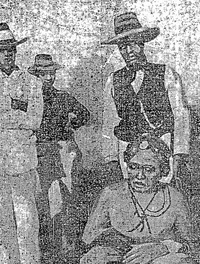Nabokov, concentration camps, and a century of civilian casualties
Vladimir Nabokov was born in 1899, less than three years after the first concentration camps were founded thousands of miles away in Cuba. What does Vladimir Nabokov—creator of decadent fiction and king of literary insults—have to do with concentration camps? It’s a reasonable question.
Like Nabokov, concentration camps were born in the nineteenth century but came into their own in the twentieth. Slave labor and forced labor camps go back thousands of years, but the concentration camp—the pre-emptive, often extra-judicial imprisonment of a civilian population—is a relatively modern phenomenon. Nabokov himself explicitly traced the Soviet Gulag back to the earliest post-Revolutionary camps, “the torture house, the blood-bespattered wall,” and the “bestial terror that had been sanctioned by Lenin.” (See http://bit.ly/13I5lOr and http://bit.ly/V9YuvU.)
 The Secret History argues that as Nabokov and the camps grew into their shared century together, he remembered them and recorded their existence in ways readers have missed—ways that transform his most famous works.
The Secret History argues that as Nabokov and the camps grew into their shared century together, he remembered them and recorded their existence in ways readers have missed—ways that transform his most famous works.
The term “concentration camp,” or “re-concentration camp,” was originally used as a phrase for any place people were gathered and housed for a particular purpose.
Today the German death camps of World War II provide the nightmare prototype for what we think of when we hear the words “concentration camp.” But the first appearance of the phrase in The New York Times actually referred to a new U.S. Army training center housing soldiers in 1898. (The same article shares the location of the camp, which, strangely enough, was listed as Falls Church, Virginia—where I live.)
Concentration camps as wartime detention facilities for civilians had actually debuted in Cuba two years before that first article. The Cuban camps had also been described in the Times, though some journalists were not yet calling them concentration camps.
Five years later, a story ran during the Second Boer War, quoting Times of London accounts of captives in the British concentration camps of Southern Africa. Afrikaner inmates were said to have detailed how healthy conditions were there, observing that “Boer women can play tennis all day if they like.” Just a month afterward, the Times was running reports that more than 12,000 civilians had died from conditions in the camps.
By mid-1903, the paper was publishing reports of atrocities and starvation in American concentration camps set up to relocate suspect populations and put down an insurrection in the Philippines. The Times likewise covered the German war against the Herero and Nama peoples in South-West Africa a year later, but did not describe role that transit camps and concentration camps came to play in the natives’ pacification and extermination.
The Secret History of Vladimir Nabokov addresses these earliest concentration camps only in passing, but pays more attention to the next stage of development, which Nabokov was old enough to witness—the worldwide internment of civilians during World War I. Hundreds of thousands of noncombatants from every country in that conflict found themselves detained for years in barracks, behind barbed wire, in abandoned factories, in makeshift villages, or other improvised quarters.
Long before his younger brother Sergei died in a German concentration camp in 1945, Nabokov made key use of the camps of the First World War in an early novel—though it was largely overlooked. And in his Russian masterwork, The Gift, he used a story within a story to offer a nonfiction account of Russian prisons and hard labor outposts that were the forerunners of the Gulag, showing how nineteenth-century oppression under the Tsars helped create the revolutionaries who would turn labor camps to more widespread and crueler use during Nabokov’s lifetime.
Given Nabokov’s Russian childhood and the years he lived in Berlin under Hitler, I expected to find many connections in his life to people who ended up in concentration camps—an expectation that turned out to be founded. But I also found other relevant history of camps that has been never known or was lost, or in some cases, simply forgotten.
In the five years I spent on the book, I tried my best to unearth the missing pieces. And I took on the (infinitely easier) task of calling attention to known but obscure history, recreating events in Nabokov’s life as internment camps became tools of punishment, torture, and execution in Russia and Germany.
Along with Nazi death factories and Stalin’s monstrous creation of the Gulag, I learned of French camps during German Occupation which deported foreign Jews and their children eastward to Auschwitz and Birkenau. I researched Allied camps in North America that interned Jewish refugees alongside Nazi prisoners of war. Nearly all of it ended up tied in some way to Nabokov’s life or work.
The concentration camp systems that overtook the countries Nabokov fled made appearances in his writing decades after he had left them behind. It’s worth remembering that though Germany took them to their most horrific extreme, the camps have a larger history, which unfolded in many other places, feeding on intolerance and fear that was far from unique to mid-twentieth-century Germany.
[Read part II on Nabokov and concentration camps.]
Image caption: “Herero Chiefs,” a detail of a picture from a New York Times’ article on the German war in South-West Africa
